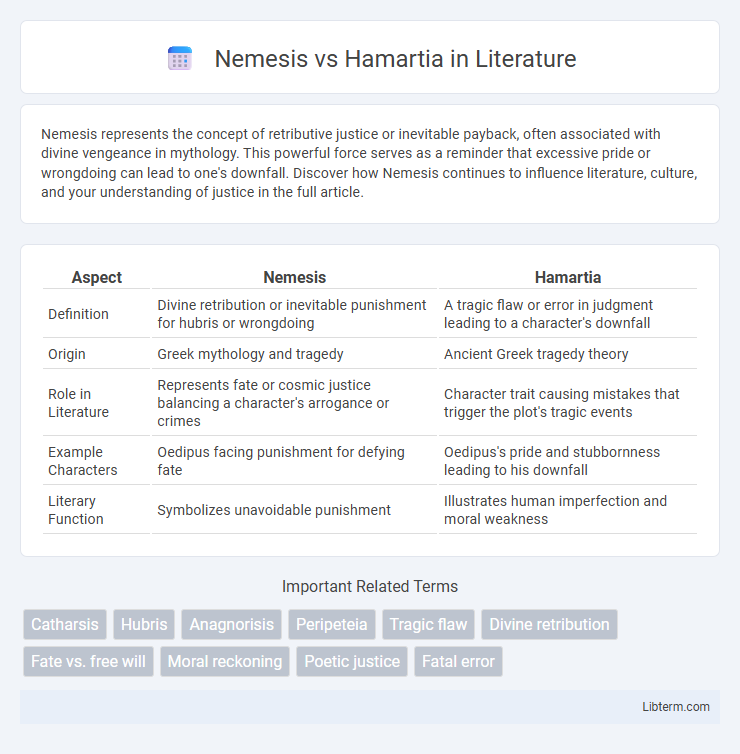Nemesis represents the concept of retributive justice or inevitable payback, often associated with divine vengeance in mythology. This powerful force serves as a reminder that excessive pride or wrongdoing can lead to one's downfall. Discover how Nemesis continues to influence literature, culture, and your understanding of justice in the full article.
Table of Comparison
| Aspect | Nemesis | Hamartia |
|---|---|---|
| Definition | Divine retribution or inevitable punishment for hubris or wrongdoing | A tragic flaw or error in judgment leading to a character's downfall |
| Origin | Greek mythology and tragedy | Ancient Greek tragedy theory |
| Role in Literature | Represents fate or cosmic justice balancing a character's arrogance or crimes | Character trait causing mistakes that trigger the plot's tragic events |
| Example Characters | Oedipus facing punishment for defying fate | Oedipus's pride and stubbornness leading to his downfall |
| Literary Function | Symbolizes unavoidable punishment | Illustrates human imperfection and moral weakness |
Introduction to Nemesis and Hamartia
Nemesis in Greek mythology represents retributive justice and divine punishment for hubris, symbolizing the inevitable downfall following excessive pride or arrogance. Hamartia refers to a tragic flaw or error in judgment within a protagonist, often leading to their demise or suffering in classical tragedy. Both concepts explore the relationship between human flaws and consequences, with Nemesis manifesting as external retribution and Hamartia as internal imperfection.
Defining Nemesis: The Concept of Divine Retribution
Nemesis embodies the concept of divine retribution, representing an unavoidable punishment for hubris or moral transgressions in Greek mythology. Unlike hamartia, which refers to a tragic flaw or error in judgment leading to downfall, Nemesis serves as the external force restoring balance by delivering just deserts. This personification of vengeance enforces ethical order by ensuring that excessive pride or wrongdoing results in proportionate consequences.
Understanding Hamartia: The Tragic Flaw
Hamartia refers to a protagonist's tragic flaw or error in judgment that leads to their downfall in classical tragedy. Unlike Nemesis, which represents retributive justice or divine punishment, Hamartia emphasizes human imperfection and the internal cause of failure. Understanding Hamartia is essential for analyzing how character weaknesses drive the narrative and elicit audience empathy in tragic literature.
Historical Origins: Ancient Greek Tragedy
Nemesis and Hamartia originate from Ancient Greek tragedy, where Nemesis represents divine retribution against hubris or excessive pride, ensuring cosmic balance and justice. Hamartia denotes a protagonist's tragic flaw or error in judgment that precipitates their downfall, emphasizing human fallibility. These concepts underscore the moral and philosophical themes central to Greek drama, reflecting societal values on fate, justice, and character.
Key Differences Between Nemesis and Hamartia
Nemesis represents divine retribution or inevitable punishment for hubris, often manifesting as an external force that balances moral order. Hamartia refers to a protagonist's tragic flaw or error in judgment that leads to their downfall, emphasizing internal character weakness. While nemesis is outcome-focused as a consequence of wrongdoing, hamartia centers on the intrinsic imperfection triggering the tragic narrative.
The Interplay of Fate and Character in Tragedy
Nemesis embodies the inescapable retribution that unfolds due to hamartia, the protagonist's fatal flaw, highlighting the tragic interplay between fate and character. In classical tragedy, hamartia represents an inherent defect or error in judgment leading to downfall, while Nemesis functions as the divine or cosmic force ensuring just punishment. This dynamic underscores how fate and personal flaws intertwine, orchestrating the protagonist's inevitable demise and reinforcing themes of moral causality and inevitability.
Literary Examples of Nemesis in Action
Nemesis manifests in literature as an inevitable force of retribution, famously exemplified in Sophocles' "Oedipus Rex," where Oedipus' relentless pursuit of truth triggers his downfall. In Shakespeare's "Macbeth," Nemesis unfolds through Macbeth's ambition-driven crimes leading to his demise, illustrating the inescapable consequences of moral transgressions. Greek tragedies frequently portray Nemesis as divine justice meted out when Hamartia, or a fatal flaw, propels protagonists toward their tragic fates.
Iconic Cases of Hamartia in Literature
Hamartia, often defined as a tragic flaw leading to a protagonist's downfall, is prominently showcased in iconic literary cases such as Shakespeare's Macbeth, whose unchecked ambition triggers his demise, and Sophocles' Oedipus, whose ignorance and fate-bound errors result in tragedy. Unlike Nemesis, which involves retributive justice or divine punishment, hamartia emphasizes the internal character flaws and moral errors causing the tragic outcome. Classic examples reveal how hamartia drives narrative arcs through fundamental human weaknesses, embodying the essence of tragic storytelling.
Influence of Nemesis and Hamartia on Modern Storytelling
Nemesis and Hamartia profoundly shape modern storytelling by providing frameworks for justice and character flaws, respectively. Nemesis embodies retributive justice, driving narratives where characters face consequences aligned with their moral failings, while Hamartia introduces tragic flaws that humanize protagonists and create emotional depth. Together, these classical concepts influence plot development and character arcs across genres, enhancing thematic complexity and audience engagement.
Conclusion: Enduring Significance in Literature and Drama
Nemesis and hamartia remain foundational concepts in literary analysis, representing the forces of retribution and human error that drive narrative conflict and character development. Their interplay highlights the complexity of fate and moral justice in classical and contemporary storytelling, influencing themes of downfall and redemption. Understanding their enduring significance enriches interpretations of tragedy and character motivation across diverse genres.
Nemesis Infographic

 libterm.com
libterm.com